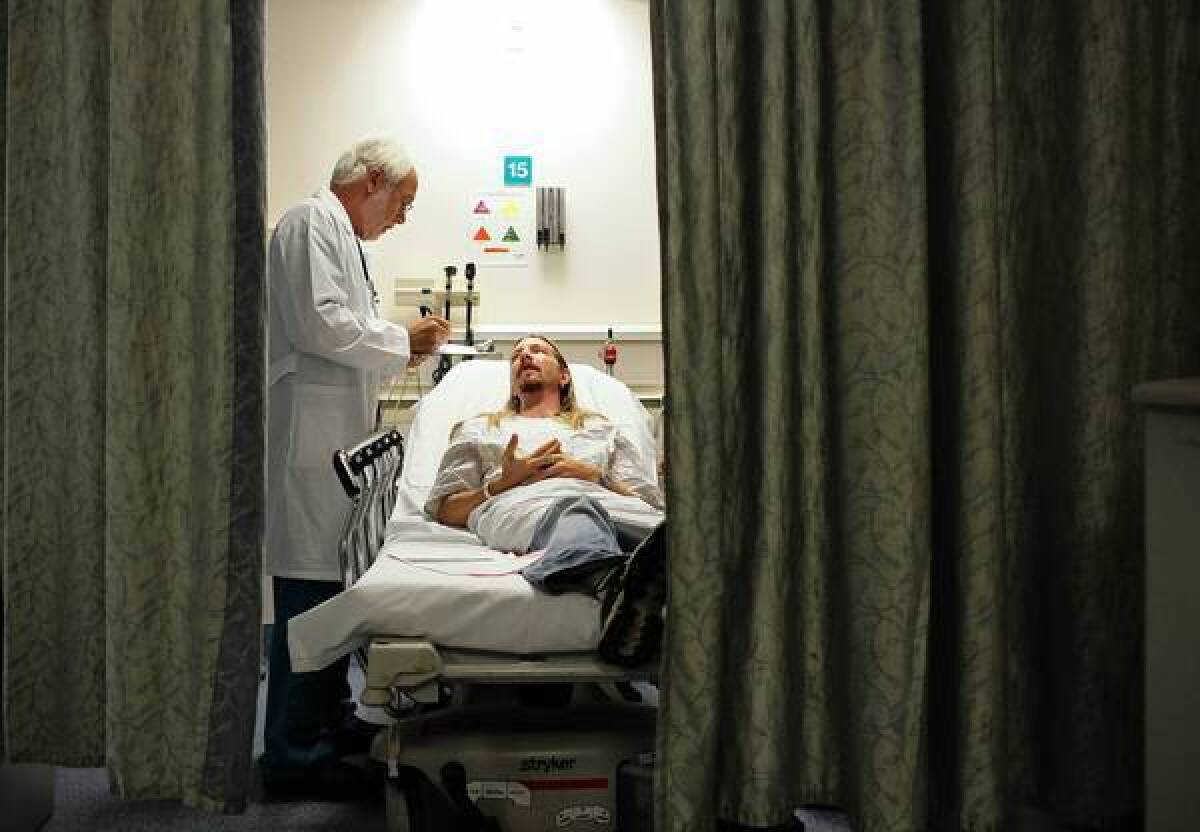Affordable Care Act presents many unknowns for California officials

- Share via
SACRAMENTO — As California positions itself at the vanguard of the national healthcare overhaul, state officials are unable to say for sure how much their implementation of the federal Affordable Care Act will cost taxpayers.
The program, intended to insure millions of Americans who are now without health coverage, takes states into uncharted territory. California, which plans to expand coverage to hundreds of thousands of people when the law takes effect in 2014, faces myriad unknowns. The Brown administration will try to estimate the cost of vastly more health coverage in the budget plan it unveils next month, but experts warn that its numbers could be way off.
Officials don’t know exactly how many Californians will sign up for Medi-Cal, the public health insurance program for the poor. Computing the cost of care for each of them is also guesswork. And California is waiting for key rulings from federal regulators that could have a major effect on the final price tag, perhaps in the hundreds of millions of dollars.
“No one has ever tried to do anything like this before,” said Michael Cannon, director of health policy studies at the Cato Institute, a libertarian think tank. “Any numbers attached to this are just a guess.”
The uncertainty comes as the state’s finances are improving but still precarious. Voters approved billions of dollars in new taxes last month, but Sacramento nevertheless faces a shortfall of $1.9 billion that must be bridged in fiscal 2013-14.
Unanticipated costs associated with the healthcare changes could undermine California’s efforts to improve its standing on Wall Street and keep the economy moving. They could force fresh cuts in services if they consume much more of the state budget than Brown is able to approximate.
In addition, some Democrats in the Legislature hope to restore certain health benefits, such as dental coverage for Medi-Cal recipients, that have been eliminated or reduced amid the persistent financial crises of recent years. The cost of any services that are revived could rise as more people become eligible for them.
Gov. Jerry Brown expressed a new concern in an interview last week. He said recent signs from Washington suggest the federal government may not pay as much of the costs associated with the new law as originally promised, sticking states with a larger share of the bill.
“As the guardian of the public purse here, I have to watch very closely what may come out of Washington,” the governor said. “So we’re going to move carefully. We want to make sure the federal government is on board.”
Cost estimates for California have differed widely.
In 2010, the year the Affordable Care Act was signed, state officials said California could be on the hook for $2.7 billion annually. The nonpartisan legislative analyst estimated this fall that initial costs would be in the “low hundreds of millions of dollars” annually for the next several years. A recent study from the nonprofit Kaiser Family Foundation pegged the price at nearly $14 billion over the next decade.
The main cost is expected to come from a sharp increase in the number of Medi-Cal enrollees. Sacramento and Washington split the bill for those Californians, who currently number roughly 8 million. The state’s share was about $14.6 billion this year.
Sacramento will be responsible for half the cost of many new Medi-Cal recipients. That number could be anywhere from 200,000 to 440,000 people in 2014, according to Ken Jacobs, chairman of the Labor Center at UC Berkeley.
Jacobs says early estimates are that these new enrollees will be cheaper to treat than current Medi-Cal recipients because they are expected to be younger and healthier. But experts caution that nobody knows for sure.
“There is a high margin of error when trying to make these estimates,” said Janet Coffman, a professor at the UC San Francisco Institute for Health Policy Studies. “And with the budget, there’s always an element of politics in terms of which sets of numbers you decide to use.”
With so many more Californians about to be insured, administration officials have suggested they would propose reducing the annual $1.4 billion Sacramento pays to counties to help them care for the uninsured. The administration is also contemplating cuts in state-funded programs aimed at the uninsured, such as breast-cancer screening and family-planning services. They say demand for such aid will fall as more people obtain coverage.
The counties, which by law are ultimately responsible for paying to treat the uninsured, would be likely to fight such moves.
“Counties will say there is still a need to keep the safety net intact and that [the state] can’t take the money before people are actually enrolled,” said Chris Perrone, deputy director of health reform and public programs at the California Healthcare Foundation, an Oakland-based nonprofit.
Even after the federal law is enacted, millions of Californians are expected to be without coverage. There are currently about 8.2 million uninsured, according to the UCLA Center for Health Policy Research. Models from UC Berkeley assume the number will be about half that by 2019.
Those who remain uninsured would still show up at hospital emergency rooms, and counties would still be responsible for their care.
Already, local officials are bracing for the worst. In a letter to Brown this month, the L.A. County Board of Supervisors expressed concern about any impending cuts.
Reducing payments to counties “prior to a full assessment and understanding” of the effects of the healthcare changes, the supervisors wrote, “is not reasonable.”
More to Read
Get the L.A. Times Politics newsletter
Deeply reported insights into legislation, politics and policy from Sacramento, Washington and beyond. In your inbox twice per week.
You may occasionally receive promotional content from the Los Angeles Times.










